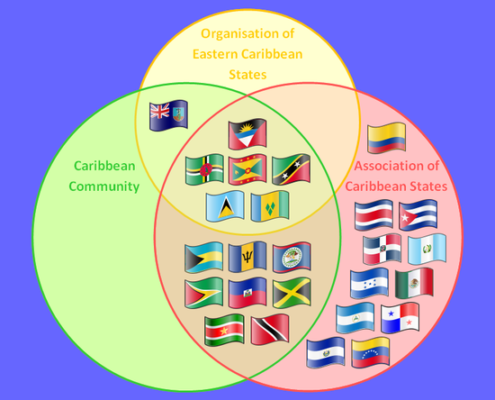Organisational structure
Structures comprised by the overall Caribbean Community (CARICOM).
Under Article 4 CARICOM breaks its 15 member states into two groups: Less Developed Countries (LDCs) and More Developed Countries (MDCs.
The countries of CARICOM which are designated as Less Developed Countries (LDCs) are:
Antigua and Barbuda
Belize
Commonwealth of Dominica
Grenada
Republic of Haiti
Montserrat
Federation of St. Kitts and Nevis
St Lucia
St Vincent and the Grenadines
The countries of CARICOM which are designated as More Developed Countries (MDCs) are.
- Commonwealth of the Bahamas
- Barbados
- Co-operative Republic of Guyana
- Jamaica
- Republic of Suriname
- Republic of Trinidad and Tobago
Chairmanship
The post of Chairman (Head of CARICOM) is held in rotation by the regional Heads of State (for the republics) and Heads of Government (for the realms) of CARICOM’s 15 member states. These include: Antigua and Barbuda, Belize, Dominica, Grenada, Haiti, Montserrat, St. Kitts and Nevis, St. Lucia, St. Vincent and the Grenadines, Bahamas, Barbados, Guyana, Jamaica, Suriname, Trinidad and Tobago.
Heads of government
CARICOM contains a quasi-Cabinet of the individual Heads of Government. These heads are given specific specialised portfolios of responsibility for overall regional development and integration.
Secretariat
Secretariat of the Caribbean Community, The term of office of the Secretary-General is five years, which may be renewed. (Chief Administrative Organ)
Secretary-General of the Caribbean Community, the CARICOM Secretary General (Chief Executive) handles foreign and community relations.
Deputy Secretary-General of the Caribbean Community, handles human and social Development.
General Counsel of the Caribbean Community, handles trade and economic integration.
The goal statement of the CARICOM Secretariat is:
To provide dynamic leadership and service, in partnership with Community institutions and Groups, toward the attainment of a viable, internationally competitive and sustainable Community, with improved quality of life for all.
Organs and bodies]
| Principal organs | |
| Organ | Description |
| CARICOM Heads of Government | Consisting of the various heads of Government from each member state |
| Standing Committee of Ministers | Ministerial responsibilities for specific areas, for example the Standing Committee of Ministers responsible for Health will consist of Ministers of Health from each member state |
Community Council
The Community Council consists of ministers responsible for community affairs and any other Minister designated by the member states in their absolute discretion. It is one of the community’s principal organs; the other is the Conference of the Heads of Government. It is supported by four other organs and three bodies.
| Secondary organs | |
| Secondary organ | Abbreviation |
| Council for Finance and Planning | COFAP |
| Council for Foreign and Community Relations | COFCOR |
| Council for Human and Social Development | COHSOD |
| Council for Trade and Economic Development | COTED |
| Bodies | |
| Body | Description |
| Legal Affairs Committee | provides legal advice |
| Budget Committee | examines the draft budget and work programme of the Secretariat and submits recommendations to the Community Council. |
| Committee of the Central Bank Governors | provides recommendations to the COFAP on monetary and financial matters. |
Institutions
The 25 designated institutions of CARICOM are as follows:
| Institutions | |
| Institution | Abbreviation |
| Caribbean Disaster Emergency Management Agency | CDEMA |
| Caribbean Meteorological Institute | CMI |
| Caribbean Meteorological Organisation | CMO |
| Caribbean Food Corporation | CFC |
| Caribbean Environment Health Institute | CEHI |
| Caribbean Agriculture Research and Development Institute | CARDI |
| Caribbean Regional Centre for the Education and training of Animal Health and Veterinary Public Health Assistants | REPAHA |
| Assembly of Caribbean Community Parliamentarians | ACCP |
| Caribbean Centre for Development Administration | CARICAD |
| Caribbean Food and Nutrition Institute | CFNI |
| Caribbean Agricultural Health and Food Safety Agency | CAHFSA |
| CARICOM Implementation Agency for Crime and Security | IMPACS |
| Caribbean Examinations Council | CXC |
| CARICOM Single Market and Economy | CSME |
| Caribbean Court of Justice | CCJ |
| Caribbean Community Administrative Tribunal | CCAT |
| CARICOM Competition Commission | CCC |
| Caribbean Regional Fisheries Mechanism | CRFM |
| Caribbean Regional Organisation for Standards and Quality | CROSQ |
| Caribbean Telecommunications Union | CTU |
| Caribbean Community Climate Change Centre | CCCCC |
| Caribbean Organisation of Tax Administrators | COTA |
| Council of Legal Education | CLE |
| Caribbean Aviation Safety and Securing Oversight System | CASSOS |
| Caribbean Regional Information and Translation Institute | CRITI |
The Caribbean Court of Justice (CCJ) is based in Port of Spain, Trinidad and Tobago and was chiefly developed to act as a settlement unit for disputes on the functioning of the Caribbean (CARICOM) Single Market and Economy (CSME) (known as “original jurisdiction”). In addition, some of the region’s Commonwealth Caribbean member states of CARICOM have opted to supplement original jurisdiction with “appellate jurisdiction” which by practice replaces the Privy Council (in London, United Kingdom) with the CCJ.
The Caribbean Public Health Agency (CARPHA) is a regional public health agency headquartered in Trinidad and Tobago which was established by CARICOM leaders in July 2011and began operation in 2013.
As of 2018, the majority of member states continue to utilize the Privy Council as their final appellate court and three member states do not use the CCJ for either its original jurisdiction or its appellate jurisdiction because they have either not signed the Revised Treaty of Chaguaramas (the Bahamas and Haiti) or are a current United Kingdom Overseas Territory (Montserrat). A handful of various public propositions have been held in several countries of CARICOM polling on public support for transitioning of appellate jurisdiction to the CCJ, and to date the majority of these measures held have failed.
Associate institutions
The six designated associate institutions of CARICOM are as follows:
| Associate institutions | |
| Associate institution | Abbreviation |
| Caribbean Development Bank | CDB |
| University of Guyana | UG |
| University of the West Indies | UWI |
| Caribbean Law Institute / Caribbean Law Institute Centre | CLI / CLIC |
| Organisation of Eastern Caribbean States | OECS |
| West Indies Cricket Board | WICB |
Standard
The flag of the Caribbean Community was chosen and approved in November 1983 at the Conference of Heads of Government Meeting in Port of Spain, Trinidad. The original design by the firm of WINART Studies in Georgetown, Guyana was substantially modified at the July 1983 Meeting of the Conference of Heads of Government. The flag was first flown on 4 July 1984 in Nassau, Bahamas at the fifth Meeting of the Conference of Heads of Government.
The flag features a blue background, but the upper part is a light blue representing sky and the lower, a darker blue representing the Caribbean Sea. The yellow circle in the centre represents the sun on which is printed in black the logo of the Caribbean Community, two interlocking Cs. The two Cs are in the form of broken links in a chain, symbolising both unity and a break with the colonial past. The narrow ring of green around the sun represents the vegetation of the region.
Song
For CARICOM’s 40th anniversary, a competition to compose an official song or anthem for CARICOM was launched in April 2013 to promote choosing a song that promoted unity and inspired CARICOM identity and pride. A regional panel of judges comprising independent experts in music was nominated by member states and the CARICOM Secretariat. Three rounds of competition condensed 63 entries to a final three, from which judges chose Celebrating CARICOM by Michele Henderson of Dominicain March 2014. Henderson won a US$10,000 prize.
Her song was produced by her husband, Roland Delsol Jr., and arranged by Earlson Matthew. It also featured Michael Ferrol on drums and choral input from the St. Alphonsus Choir.
It was re-produced for CARICOM by Carl Beaver Henderson of Trinidad and Tobago. A second-place entry titled My CARICOM came from Jamaican Adiel Thomas[27] who won US$5,000, and a third-place song titled One CARICOM by Carmella Lawrence of St. Kitts and Nevis, won US$2,500 The other songs from the top-ten finalists (in no particular order) were:
One Region one Caribbean from Anguilla,
One Caribbean Family from Jamaica,
CARICOM’s Light from St. Vincent & the Grenadines,
We Are CARICOM from Dominica,
Together As one from Dominica,
Blessed CARICOM from Jamaica,
Together We Rise from Jamaica.
The first official performance of Celebrating CARICOM by Henderson took place on Tuesday 1 July 2014 at the opening ceremony for the Thirty-Fifth Regional Meeting of the Conference of Heads of Government in Antigua and Barbuda.



